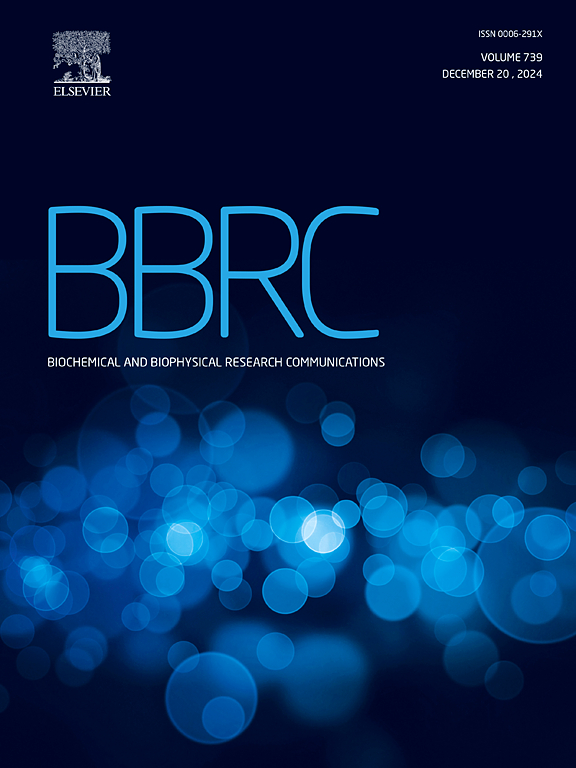渗透压对抗菌肽诱导孔膜渗透的影响
IF 2.2
3区 生物学
Q3 BIOCHEMISTRY & MOLECULAR BIOLOGY
Biochemical and biophysical research communications
Pub Date : 2025-01-01
DOI:10.1016/j.bbrc.2024.151180
引用次数: 0
摘要
大多数抗菌肽(AMPs)诱导细胞膜损伤,如细菌细胞的孔形成,导致细胞快速死亡。另一方面,细菌细胞具有较大的胞内膨压,即渗透压(Π),这是由于细菌细胞内渗透压较高,但Π对脂质囊泡内部内容物和细胞通过amp诱导的孔隙的膜渗透的影响尚不清楚。在这里,我们研究了Π对水溶性荧光探针AlexaFluor 488 hydrazide (AF488)通过肽基-甘氨酸-羧酸酰胺(PGLa)或magainin 2 (Mag)诱导的巨型单层囊泡(GUVs)纳米孔时膜通透性的影响。在Π条件下,PGLa与单个guv相互作用时,膜透性系数MP逐渐增加,直至MP达到稳定值Ps。而在Π条件下,Mag与单个guv相互作用时,膜透性系数MP迅速变为Ps,较小的Π值增强了AF488通过PGLa或Mag诱导的纳米孔的Ps值。讨论了小Π值下Ps增加的机制。基于这些结果和我们之前的结果,膜张力(由于Π)提高了amp诱导的孔形成率,我们考虑了膨胀压力在amp诱导的细菌膜损伤和内部内容物外排中的作用。本文章由计算机程序翻译,如有差异,请以英文原文为准。
Effect of osmotic pressure on membrane permeation through antimicrobial peptide-induced pores
Most antimicrobial peptides (AMPs) induce membrane damage such as pore formation in bacterial cells, resulting in rapid cell death. On the other hand, bacterial cells have a large intracellular turgor pressure, i.e., an osmotic pressure (Π) due to higher osmolarity inside bacterial cells, but the effects of Π on the membrane permeation of the internal contents of lipid vesicles and cells through AMP-induced pores are unknown. Here, we investigated the effect of Π on the membrane permeability of a water-soluble fluorescent probe, AlexaFluor 488 hydrazide (AF488), when passing through peptidyl-glycylleucine-carboxyamide (PGLa)- or magainin 2 (Mag)-induced nanopores in giant unilamellar vesicles (GUVs). For the interaction of PGLa with single GUVs under Π, the onset of pore formation was followed by a gradual increase in the membrane permeability coefficient, MP, until MP reached a steady value, Ps. On the other hand, for the interaction of Mag with single GUVs under Π, the onset of pore formation was rapidly followed by a change of MP to Ps. Small Π values enhanced the Ps values of AF488 passing through the PGLa- or Mag-induced nanopores. The mechanisms underlying the increase of Ps at small Π values were discussed. Based on these results and our previous results that the membrane tension (due to Π) enhances rate of AMP-induced pore formation, we consider the role of turgor pressure in AMP-induced damage in bacterial membranes and the efflux of internal contents.
求助全文
通过发布文献求助,成功后即可免费获取论文全文。
去求助
来源期刊
CiteScore
6.10
自引率
0.00%
发文量
1400
审稿时长
14 days
期刊介绍:
Biochemical and Biophysical Research Communications is the premier international journal devoted to the very rapid dissemination of timely and significant experimental results in diverse fields of biological research. The development of the "Breakthroughs and Views" section brings the minireview format to the journal, and issues often contain collections of special interest manuscripts. BBRC is published weekly (52 issues/year).Research Areas now include: Biochemistry; biophysics; cell biology; developmental biology; immunology
; molecular biology; neurobiology; plant biology and proteomics

 求助内容:
求助内容: 应助结果提醒方式:
应助结果提醒方式:


